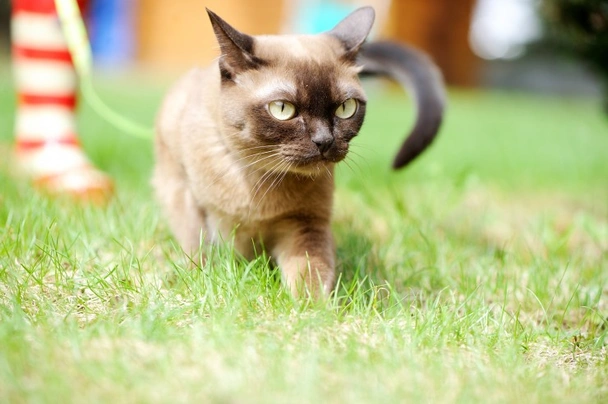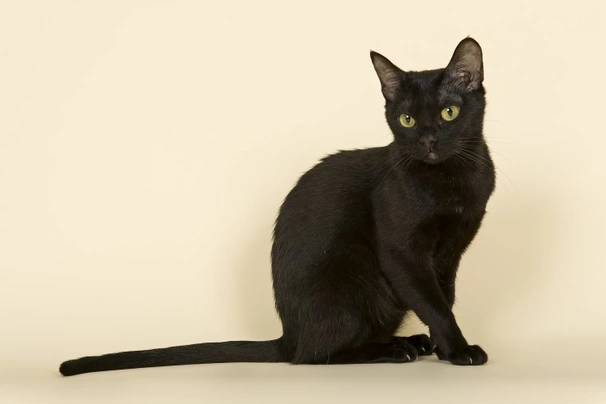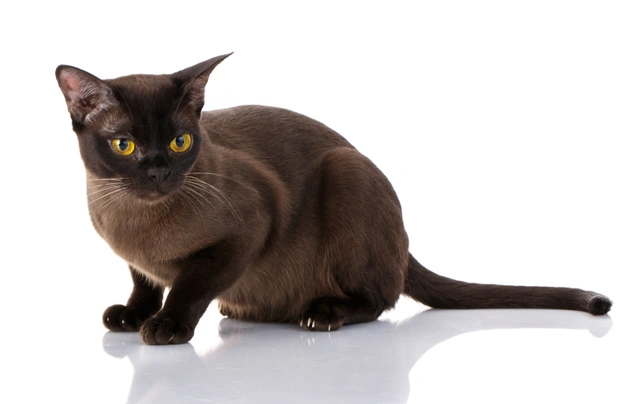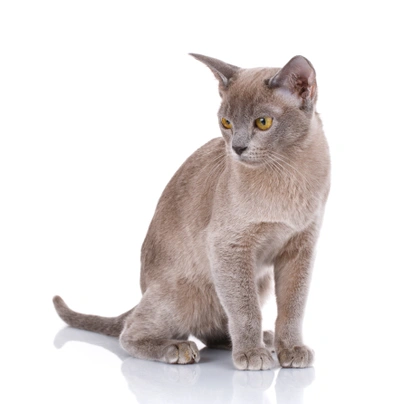Asian
Introduction of the Asian
The Asian breed incorporates a few cat groups all of which boast having the look of a Burmese and a similar texture to their coats. There's a vast range of colour combinations and coat patterns all of which are acceptable under the GCCF breed standard but each colour is referred to as being either "Full Expression" or "Burmese Colour Restriction". In short a cat can either have the colour of the Burmese or they can be much darker and this includes black.
There are five types of Asian cats all of which have become popular both as companions and family pets thanks to their exotic foreign appearance and their charming affectionate natures. They are known to be particularly good with the elderly loving nothing more to entertain and be entertained. Asians are also incredibly loyal to their families.
History of the Asian
The Asian was first bred in Britain and in reality the breed came about by mistake when a female Lilac Burmese mated with a male Chinchilla Persian in 1981. These cats produced a litter of four kittens which proved to be extremely attractive. This led to the breed being developed with an end goal being to produce a good looking healthy cat that would receive GCCF recognition.
In the early days breeders thought it best to use breeds that boasted the same “type” as the Burmese but they wanted to introduce more colours and patterns into their new breed. Breeders also wanted to develop both a short haired cat and a semi longhaired cat. It was decided the new breed should be named "Asian" and in 2003 the GCCF recognised all five types of Asians and awarded the breed Championship Status.
Today all five Asians are among the most popular choices both as family pets and companions not only in the UK but elsewhere in the world too. They have found their way into the hearts and homes of many people thanks to their rather exotic foreign looks their lively affectionate and loyal personalities.
Interesting facts about the breed
- Is the Asian a rare breed? No they have fast become one of the most popular breeds in the UK and in the showring
- Asians must be of “good temperament” which is a trait that is specified in their breed standard
- Female Asians have their first heat when they are anything to 7 to 8 months old
- Kittens in a litter of Burmese cats can be Asians because both breeds are so closely related
- There can be Burmese and Asians in a single litter
Appearance of the Asian
As previously mentioned there are five groups that make up the Asian which are as follows:
- Burmilla – cats can have silver (white) or standard (pale cream) base coats with colours on the top half quarter of each hair shaft
- Self – cats have a plain colour on their hair shafts – it is worth noting that the Bombay is categorised in this group
- Smoke – cats should ideally have colour half way down a hair shaft and should have a silver undercoat
- Tabby – cats can have 4 patterns to their coats with the dominant one being ticked then mackerel spotted and classic. All 4 patterns can be silver or standard
- Tiffanie – cats have semi-longhaired coats and can be any colour and pattern
The other Asian types are called "Variants" which are cats that look exactly like the Burmese and which can be used in breeding programmes as long as they are used to improve the breed. However Variants cannot be exhibited. The variants that make up the Asian Group are as follows:
Asians whether they have semi long-hair or short coats are medium size cats referred to as foreign types. They are elegant well-proportioned cats that always have an alert intelligent look about them and they boast having a gentle friendly nature. They have quite short wedge-shaped head with wide cheekbones. Muzzles are rather blunt but cats have a nice width at their jaw line. The top of an Asian's head is slightly rounded between their ears which are set well apart on the head. Viewed in profile cats have a distinct nose break and frim chins with level bites.
Their necks are moderately thick and nicely in proportion with the rest of the body. The size of their ears are medium to large and set well apart and being broader at the base and nicely rounded at the tips. The outline of a cat's ears continues the line of the upper part of a cat's face so that it produces a sort of butter-fly wing effect when seen from the front. Tiffanies have tufts and streamers on their ears. Their eyes are large and set well apart on a cat's face with the top lid having a gentle curve that slants towards the nose. Their lower lid is that much fuller and rounded which gives the Asian their "foreign" look.
Asians have slender moderately long bodies that are lithe and well-muscled being heavier than they actually appear to be. They have straight backs from their shoulders to their rumps and chests are generous gently rounded but never overly broad. Their legs are slender elegant and moderately long being nicely in proportion to the rest of a cat's body. Their back legs are longer than their front ones and paws are oval-shaped and neat. Tails are medium to long being quite thick at the base before tapering to a rounded tip which adds to the well balanced look of an Asian and they carry their tails proudly.
When it comes to their coat the Asian boasts having a short fine and close-lying coat that's smooth and silky to the touch which always has a nice sheen on it. Semi-Longhaired Asians (Tiffanies) have medium length silky fine coats all over the bodies with the exception of over their shoulders and they do not have a woolly undercoat.
An Asian's eye colour can be yellow right through to green depending on the type. However in Silver Asians the preferred colour is green whereas in Selfs a rich yellow to deep gold is preferred under the breed standard. Asians come in a variety of colours which includes the following but there are many more colour and pattern variations that are acceptable under the GCCF breed standard:
- Black (Full Expression Colour)
- Brown (Burmese Colour Restriction)
- Blue (Full Expression Colour)
- Blue (Burmese Colour Restriction)
- Chocolate (Full Expression Colour)
- Chocolate (Burmese Colour Restriction)
- Lilac (Full Expression Colour)
- Lilac (Burmese Colour Restriction)
- Red (Full Expression Colour)
- Silvers/Smokes
- Red (Burmese Colour Restriction)
- Cream (Full Expression Colour)
- Cream (Burmese Colour Restriction)
- Caramel (Full Expression Colour)
- Caramel (Burmese Colour Restriction)
- Apricot (Full Expression Colour)
- Apricot (Burmese Colour Restriction)
- Cinnamon (Full Expression Colour)
- Cinnamon (Burmese Colour Restriction)
- Fawn (Full Expression Colour)
- Fawn (Burmese Colour Restriction)
- Black Tortie (Full Expression Colour)
- Brown Tortie (Burmese Colour Restriction)
- Blue Tortie (Full Expression Colour)
- Blue Tortie (Burmese Colour Restriction)
- Chocolate Tortie (Full Expression Colour)
- Chocolate Tortie (Burmese Colour Restriction)
- Lilac Tortie (Full Expression Colour)
- Lilac Tortie (Burmese Colour Restriction)
- Caramel Tortie (Full Expression Colour)
- Caramel Tortie (Burmese Colour Restriction)
- Cinnamon Tortie (Full Expression Colour)
- Cinnamon Tortie (Burmese Colour Restriction)
- Fawn Tortie (Full Expression Colour)
- Fawn Tortie (Burmese Colour Restriction)
- Bombay and Asian Selfs
- Asian Smoke
- Asian Shaded - Burmilla
- Asian Tabbies
- Black (Full Expression Colour)
- Brown (Burmese Colour Restriction)
- Blue (Full Expression Colour)
- Tiffanie
Faults
Faults in the breed include the following:
- Pinched muzzles in mature Asians
- Dished or flat brows
- Distinct bump on nose in mature Asians
- A cat’s nose leather falls markedly away
- Extreme coat colours
Temperament of the Asian
The Asian boasts being a placid even-tempered cat and one that thrives in a home environment loving nothing more than to be involved in everything that goes on in a household. They are inquisitive and fun-loving which is why they have remained among the most popular companions and family pets not only in the UK but elsewhere in the world too.
They are gentle and loyal by nature which is one of the reasons why they make such great companions for older people. With this said they can often act like real "clowns" when the mood takes them. They are super-intelligent and learn new things very quickly and they enjoy playing interactive games. Many Asians retain their kitten-like natures well into their senior years bearing in mind they have very long lifespans when well cared for and fed an appropriated diet to suit their ages.
Asians are known to get on with other cats more especially if they have grown up together. However introducing a new cat into the environment can be challenging until a "pecking" order has been established that is. Asians love to be out and about exploring their environment and marking their territory. However cats should only be let out if it is safe for them.
In short living in town or near a main road can pose lots of dangers to cats which means that many owners decide to keep their Asians as indoor pets which they adapt to very well. With this said it’s important to invest in lots of interactive toys and building high platforms for cats to climb to when they feel the need to look down on the world below when they are kept as indoor pets to prevent boredom from setting in.
Asians although not overly talkative will hold a conversation with their owners when encouraged and have a good range of sounds that allows them to quickly let people know what kind of mood they are in. They are very people-oriented and form strong bonds with their owners. However they do stress out when left on their own because they are so people oriented and hate it when they are on their own for extended periods of time.
Are they a good choice for first time owners?
Asians are a great choice for first time cat owners because they are so loving gentle and intelligent. They are also deeply loyal and make wonderful companions for the elderly.
What about playfulness?
The Asian is an outgoing cat albeit laid back character and one that loves to entertain. As previously mentioned they remain very kitten-like well into their golden years. They are quick learners and being so inquisitive by nature Asians enjoy playing lots of interactive games. They also love to be up high so they can look down on the world below. As such Asians kept as indoor pets should have plenty of places they can climb on which is a great way of keeping cats entertained.
What about adaptability?
Being so intelligent Asians adapt well to being kept as indoor cats providing they are given lots to do to keep them occupied. It is also important not to leave an Asian to their own devices for long periods of time because they are so people-oriented**.**
What about separation anxiety
Asians are very loyal by nature and love being involved in everything that goes on in the family. As such they never like it when they are left on their own for too long the reason being that Asians crave companionship.
Are they vocal?
Asians are not known to be overly vocal but this is not to say that they won’t hold quiet conversations with their owners more especially at meal times and when they want some attention.
Do Asians like water?
Like many other breeds Asians are not particularly fond of water although they do enjoy playing with a dripping tap and some cats will play with the water in their bowls when the mood takes them as a way of keeping themselves and their owners entertained.
Do they get on with dogs?
Asians are very social cats by nature and get on with dogs they have grown up with. However introducing them to dogs they don’t already know should always be well supervised just in case the dog does not like cats.
Intelligence / Trainability of the Asian
Asians are known to be smart cats that learn new things quickly. They love playing interactive games which includes things like "fetch". They are very sensitive to a person's mood and will quickly pick up on when an owner is feeling down. They are also sensitive to an owner's tone of voice and do not like being told off harshly. They enjoy being involved in everything that goes on in their household and being so inquisitive Asians like to check things out which includes shopping bags inside cupboards and the tops of high furniture which allows them to perch and watch what’s going on down below.
Children and other
Asians are the perfect family pet because they are social cats by nature. They get on with everyone and enjoy playing interactive games with children. However any interaction between toddlers and cats should always be well supervised by an adult to make sure things stay nice and calm. It's also important for younger children to be taught how to handle and behave around cats and when to leave them alone.
Health of the Asian
The average life expectancy of an Asian is between 16 and 18 years when properly cared for and fed an appropriate good quality diet to suit their ages.
The Asian is known to suffer from a few hereditary health issues which are worth knowing about if you are planning share your home with one of these lovely cats. The conditions that seem to affect the breed the most include the following:
- Autosomal dominant polycystic kidney disease - breeders must have stud cats tested which is obligatory under the GCCF standard
- Burmese Hypokalaemia - test available – breeders must have stud cats tested which is obligatory under the GCCF standard
- Progressive retinal atrophy (PRA) - stud cats should be DNA tested
- Hypokalaemia - breeders must have stud cats tested which is obligatory under the GCCF standard
It is essential that Asians with 2 copies of the HK recessive gene responsible for hypokalaemia polymyopathy should not be used for breeding purposes.
Caring for the Asian
As with any other breed Asians need to be groomed on a regular basis to make sure their coats and skin are kept in top condition. On top of this cats need to be fed good quality food that meets all their nutritional needs throughout their lives which is especially true of kittens and older cats.
Caring for an Asian Kitten
Asian kittens should be older than 12 weeks old when rehomed and they should have been given 2 vaccinations against Cat Flu and Feline Infectious Enteritis which is typically done when a kitten is 9 weeks old and then again when they are 12 weeks old. A responsible breeder would always give a new owner a diet sheet detailing how often and what to feed a kitten and it’s important to stick to the schedule to avoid any digestive problems.
It’s essential for homes to be “kitten-proofed” well before a young cat is introduced into a new home and it is always a good idea to keep a kitten in one room and to limit their access to the entire house. If there are children in the household it’s important to teach them how to behave around a kitten how to handle their new pet and when to leave a kitten alone.
Kittens need time to get used to their new surroundings so it is important for them not to be overwhelmed. They need to have a “safe” place which is why it’s a good idea for them to be kept in one room until they become more confident and get used to all the new noises and smells of a home.
Asian kittens are intelligent and they are very inquisitive which means they can get themselves in all sorts of trouble which is why it is so important to “kitten-proof” a home. They also have a very low boredom threshold and even when young they adore human company or the companionship of a family pet or other cat. It is also worth noting that Asians even when young are very capable of opening doors.
Litter trays must be kept clean because if dirty a kitten may refuse to use it and instead do their “business” somewhere else which can be behind furniture making it harder to clean up. Clumping litter must be avoided just in case a kitten decides to eat any of it which could end up causing a blockage in their digestive tract. Once a kitten is nicely settled into a new home their diets can be changed but this must be done slowly over a few weeks to avoid a tummy upset.
When it comes to neutering and spaying the procedures should be done by a qualified vet when cats are 6 months old and never earlier. Kittens should not be let outside until they are fully vaccinated againstFeline Leukaemia Virus (FeLV) and Feline Immunodeficiency Virus (FIV).
What about when they reach their senior years?
Like all other cats Asians when they reach their golden years need more in the way of care and veterinary attention when it comes to checking their teeth. Cats tend to suffer from gingivitis which can lead to serious problems if not dealt with in time. It is also important to feed an older cat a diet to suit their ages bearing in mind that many older cats suffer from kidney disease.
Grooming of the Asian
Asians boast having short close lying coats and as such they are low maintenance on the grooming front. A weekly brush and wipe over with a chamois leather is all it takes to keep their coats in good condition with a nice sheen on it. However Tiffanies have semi-longhair which means they are slightly higher maintenance when it comes to keeping their coats in good condition. Both shorthair and semi-longhair Asians shed steadily throughout the year only more so during the Spring and then again in the Autumn when more frequent grooming is usually necessary to stay on top of things and to remove dead and shed hair from a cat's coat.
It's also important to check a cat's ears on a regular basis and to clean them when necessary. If too much wax is allowed to build up it can lead to a painful infection which can be hard to clear up. In short prevention is often easier than cure with ear infections. Cats often suffer from ear mites which can be a real problem if left untreated.
Exercise of the Asian
As previously mentioned if you get an Asian kitten from a breeder they would give you a feeding schedule and it's important to stick to the same routine feeding the same kitten food to avoid any tummy upsets. You can change a kitten's diet but this needs to be done very gradually always making sure they don't develop any digestive upsets and if they do it's best to put them back on their original diet and to discuss things with the vet before attempting to change it again.
Older cats are not known to be fussy eaters but this does not mean they can be given a lower quality diet. It's best to feed a mature cat several times a day making sure it's good quality food that meets all their nutritional requirements. It's also important that cats be given the right amount of exercise so they burn off any excess calories or they might gain too much weight which can lead to all sorts of health issues. Obesity can shorten a cat's life by several years so it's important to keep an eye on their waistline from the word go.
Feeding guide for an Asian Kitten
As a rough guide an Asian kitten should be fed the following amounts in any 24 hour period making sure they are fed little and often:
- 2 to 3 months – 60g/94g kibble or 32g/65g kibble mixed with 1 sachet of wet food depending on weight
- 4 to 6 months – 75g/100g kibble or 58g/78g kibble mixed with 1 sachet wet food
- 7 to 9 months – 73g/90g kibble or 54g/68g kibble mixed with 1 sachet wet food
- 10 to 12 months – 64g/84g kibble or 48g/60g kibble mixed with 1 sachet wet food
Feeding guide for an adult Asian
Adult Asians should be fed a good quality diet to suit their ages. As a rough guide an mature cat should be fed the following amounts in any 24 hour period:
- Cats weighing 8 kg to 15 kg can be fed 70g/95g of kibble or 30g/45g of kibble mixed with 1 sachet of wet food depending on age and activity
Feeding of the Asian
If you are looking to buy an Asian you would need to pay upwards of £500 for a well-bred pedigree kitten. The cost of insuring a male 3-year-old Asian in northern England would be £15.83 a month for basic cover but for a lifetime policy this would set you back £27.23 a month (quote as of July 2019). When insurance companies calculate a pet's premium they factor in several things which includes where you live in the UK a cat's age and whether they have been neutered or spayed amongst other things.
When it comes to food costs you need to buy the best quality food whether wet or dry making sure it suits the different stages of a cat’s life. This would set you back between £10 - £15 a month. On top of all of this you need to factor in veterinary costs if you want to share your home with an Asian and this includes their initial vaccinations their annual boosters the cost of neutering or spaying a cat when the time is right and their yearly health checks all of which quickly adds up to over £400 a year.
As a rough guide the average cost to keep and care for an Asian would be between £25 to £40 a month depending on the level of insurance cover you opt to buy for your cat but this does not include the initial cost of buying a well-bred GCCF registered Asian kitten.
Asian price

Ketten
£50
Stunning Asian Tiffany (Devon EX6).
£100



